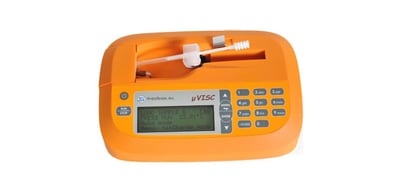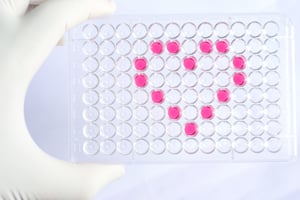When determining the best instrument for your rheology measurements, specifically viscosity, you want to have a firm understanding of the volume of sample you have available for testing. It is crucial to have the sample volume available that is required by the instrument for testing.  Small sample volume availability is a common challenge for viscosity measurements, especially when working in formulation or when measuring costly samples (ex: proteins, specialty chemicals, oils, etc). Small sample volume viscosity measurement is especially important in early stage drug development as candidate drugs are often available only in small quantities.
Small sample volume availability is a common challenge for viscosity measurements, especially when working in formulation or when measuring costly samples (ex: proteins, specialty chemicals, oils, etc). Small sample volume viscosity measurement is especially important in early stage drug development as candidate drugs are often available only in small quantities.
The VROC platform allows for extremely small volume sample screening and non-destructive recovery of early stage samples. VROC instruments require a minimum of 15µL needed for testing (with an average sample testing size in the ~hundred µL range), whereas other instruments such as a rotational viscometer or a capillary tube require tens of mL of sample. Measuring small sample volumes (~hundred µL range) gives many advantages for viscosity measurements, including convenience, accuracy, safety, cost reduction and simplified testing processes.
Proteins and chemicals can cost over $400 per mL, making it important to use as little as possible for testing and characterization. Testing small volumes of these samples optimizes formulation and quality testing. The ability to identify viscosity changes from one batch to another helps to identify batch inconsistencies and quality. With the ability to collect accurate and reliable viscosity data from small volumes, the microVISC viscometer is an ideal solution for efficient quality control testing.
In an application using the microVISC™, we were able to to save half of the measurement time & sample when compared to capillary viscometers. Access application note here. Safety is another area of concern when testing samples. Using minimal amounts of dangerous or hazardous materials when testing is beneficial. Many samples, especially in biopharmaceutical and chemical industries, can exhibit dangerous properties such as volatile or acidic behavior. Reducing the amount of material needed for testing is one of the most effective risk mitigation strategies when working with these solutions.
Safety is another area of concern when testing samples. Using minimal amounts of dangerous or hazardous materials when testing is beneficial. Many samples, especially in biopharmaceutical and chemical industries, can exhibit dangerous properties such as volatile or acidic behavior. Reducing the amount of material needed for testing is one of the most effective risk mitigation strategies when working with these solutions.
By requiring small volume of sample to provide accurate and reliable viscosity measurements, RheoSense VROC viscometers provide flexibility, convenience and added safety for end users. Contact us to learn more about how you can save money and improve your viscosity measurements with our VROC technology.
Written by: Eden Reid, RheoSense Senior Marketing and Sales Operations


